
As the fastest growing and most popular delivery method in the nation, design-build is changing the way America builds. There are incredible innovations and evolutions being implemented by design-build teams on projects each and every day. This new feature will provide DBIA members an opportunity to share their perspectives on what works, what doesn’t and how to deliver the best design-build projects in the nation.
![]()
Contributed by:
Geoff Neumayr, SE
Chief Development Officer
San Francisco International Airport, Planning, Design & Construction Division
Diane Anglin
Communications Executive
Clark Construction Group, DBIA Western Pacific Region Board President Emeritus
The growing use of integrated project delivery means large collaborative teams are more the norm than ever before. A higher number of firms working together in open workplace environments is literally changing our industry and the way we deliver our nation’s vital projects in both the public and private sector. Research shows collaboration can deliver better outcomes but how well are we collaborating? What is working and what isn’t?
We asked these questions and many more in a survey of experienced practitioners and Owners working in both large and small collaborative teams in the Design-Build Institute of America’s (DBIA) Western Pacific Region. We received 58 responses that provide insight into how project teams are using collaboration, how team members’ individual traits impact success, the challenges facing integrated teams and keys to delivering successful collaborative projects. We also polled members at the 2018 Design-Build Institute of America Western Pacific Regional conference. Together, these results provide an interesting look into how collaborative teams are performing.
Which Personal Traits Are Critical to Successful Collaboration?
The survey asked participants to rank a list of traits critical for successful collaboration: creativity, decisiveness, discipline, honesty, humility and listening.
The responders ranked honesty as the most important with 53% naming it number one, followed by listening (26%) and humility (14%). “Nothing demonstrates respect more than listening,” says David Verble with the Lean Enterprise Institute. “Real respect feels like knowing you’re being heard.” Surprisingly, creativity, which is a trait vital to innovation and a hallmark of collaborative delivery, was not ranked “most important” by a single respondent.
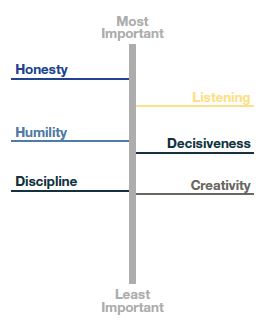
Together, the survey’s top-ranked traits of honesty and listening help build the foundation for the open (and possibly difficult) dialogue necessary to build trust among the team. As described by Barbara J. Jackson, Ph.D., FDBIA, Chair, Burns School of Real Estate and Construction Management, University of Denver in Design-Build Essentials, “Design-build is meant to operate in an environment of trust … Bottom line, no trust — no team.”
As a second-level test of the same question, approximately 80 audience members were asked to take an interactive poll on those same traits during a presentation at the 2018 Design-Build Institute of America Western Pacific Regional conference in San Diego. The presentation was given by representatives from San Francisco International Airport, Cedar-Sinai Medical Center, Gensler, Clark Construction and McCarthy Building Companies.
The results of this ranking resulted in the very same results as the digital survey: honesty winning the top trait, followed by listening. And once again, creativity received no votes as the most important collaborative trait. We believe this does not mean teams don’t value creativity. These results suggest the priority is to build the foundation of trust (honesty + listening) upon which innovation can then grow.
“The fact that results from both the survey and presentation exercise mirror each other so exactly suggests teams know that listening to truth is the vital ingredient for building trust and ultimately a successful collaboration,” according to presentation team member Felipe Engineer-Manriquez, with McCarthy Building Companies.
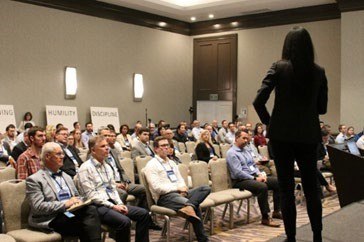
Personal Traits vs Team Building
With the recent emphasis on team building events to foster relationships and boost team morale, the survey questions compare the importance of team building against the effects that team members’ personality traits have on effectiveness. Respondents say the traits of the team members were more important than structured team interactions.
QUESTION: WHAT PLAYS A MORE IMPORTANT ROLE IN SUCCESSFUL COLLABORATION RESULTS?

55% of respondents indicated that the traits of the team members were more important than structured team activities. While team building can enhance a team’s effectiveness, respondents believe it’s more important that the right team is in place from the start. Simply put, no number of barbeques can fix a lack of honest communication and trust.
HOW PERSONALITIES IMPACT WORK
The survey also asked questions relating to personalities in order to determine their effects on the work delivered in open work environments. The results indicate an unfortunate reality impacting many team members. Personality conflicts are prevalent on the vast majority of teams. Only 19% of respondents reported “none at all” when asked about the prevalence of personality conflicts on a recent collaborative project.
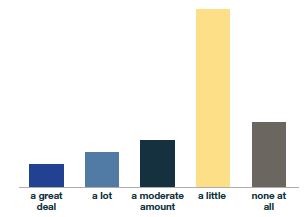
No project will ever be problem-free. However, how the team works to identify, communicate and collaboratively address problems differentiates successful from unsuccessful teams. Personality conflicts, when addressed as early as possible, can save a team before their work is derailed. By creating a culture of honest communication, the team creates a “safety zone” where airing issues early is an expected behavior. It helps prevent “issues” from becoming problems which then threaten the team and the entire project. San Francisco International Airport’s Delivering Exceptional Projects guidelines establish the safety zone for issue resolution in order to prevent the team going into the problem zone.
“It takes discipline and perseverance to keep the principles of fairness and the best interest of the project in mind, especially in the middle of any conflict… But excellence is the result of an exceptional group of people working hard in an atmosphere of good will and structured cooperation.”… Delivering Exceptional Projects, San Francisco International Airport
Who Leads the Culture?
The survey results indicate the collaborative culture of the team is set by both the Owner as well as the lead contract-holding design-builder. Requirements and expectations set by Owners have a definitive effect on how teams organize and operate. However, regardless of the client’s requirements, the lead design-builder can create the environment that best supports collaboration and positive outcomes and take ownership of behaviors of the team.
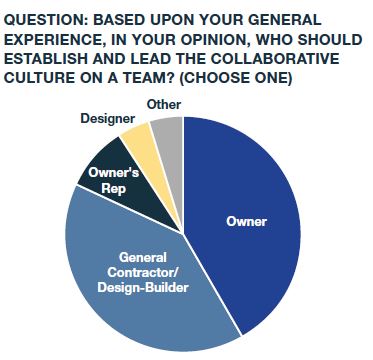
Harnessing Potential
Gallup research has shown that putting people in roles that fit their talent promotes employee engagement and improves business performance. Collaborative teams with diverse, experienced experts working toward a common goal provide an incredible opportunity to innovate and solve complex problems far beyond the skills of any one team member. We asked our participants if their project teams have fully utilized their skills.
QUESTION: ON A RECENT COLLABORATIVE PROJECT, I FELT THAT MY TALENTS WERE USED TO THEIR POTENTIAL.

According to those polled, the industry is doing well at matching the work with the right people. This is an important milestone, as the underutilized talent is considered one of the Lean Construction Institute’s top wastes in design and construction.
Solving Problems Collaboratively
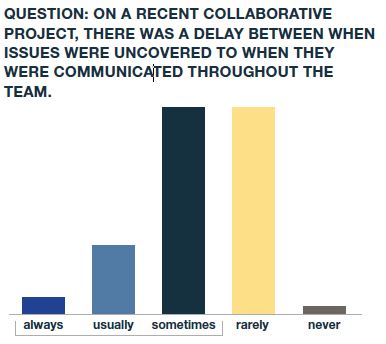
Although an open environment ultimately increases communication, 55% of the respondents indicated that on their integrated projects, there was a delay (sometimes, usually or always) between when issues were uncovered and when they were communicated throughout the team. Withholding information could be an indicator of protecting self-interest or a non-safe environment with fear of retaliation, rather than a focus on project outcomes. A delay in communicating project issues to the entire team happens a vast majority of the time with only 1% of responders indicating delayed communication never happens.
This delayed communication presents a real obstacle for teams because there is a continuum of challenges that happen long before a dispute or claim exists. Issues lead to problems, problems lead to disputes, disputes lead to claims, claims then lead to litigation. Our industry has, over time, developed robust mechanism to deal with litigation and claims. We also have developed management tools to identify problems such as critical path scheduling, risk registers and estimating, but the objective of these systems is to place blame, and transfer responsibility to the individual party responsible for causing the problem.
What our industry has not done very well is develop systems to identify issues early. While issues and problems look almost identical, there is a difference in that problems are widely known because a person or entity has been damaged financially, emotionally or even physically. With the damage done, the only solution is mitigation. Issues, however, differ because no person or entity has been harmed at the early stages and while problems are obvious to all, issues are hidden away in individual team members’ perspectives and opinions of the issue.
Our challenge is to get those issues out of individuals’ heads and communicated effectively so the team can work together to resolve issues before damage is done. Both the Lean Construction Institute and International Partnering Institute’s primary objective is to develop environments of measuring, learning, honesty, trust and collaboration so that issues can be brought to the collective wisdom of the entire project team. Allowing team members to work through issues before they become problems helps develop a high performing team that delivers excellence. “Bad news early is better news because it allows the team to take action. When evaluating root cause or mitigation measures, the team should be hard on the process and soft on the people. They should take blame out of the equation to improve the process.” Ron Migliori, Buehler Engineering Inc.
Putting the Data to Work
Respondents have told us about the most important traits for collaborative team members, the role of team leaders and the importance of trust built by honest communication and listening. The challenge is putting that information to work to build more effective and successful collaborative teams.
Selecting the Right Team
Who are the right people for a successful collaborative team? Clearly, choosing the right team is a critical step to delivering a successful project and yet it is too-often underestimated. The Design-Build Institute of America’s Universal Best Practices recognizes the vital importance of ensuring team members are willing to work collaboratively.
- All members of the design-build team must understand that the project’s success is dependent on the ability of the team members to work collaboratively and to trust that each member is committed to working in the best interests of the project.
- Projects should be staffed with individuals that are educated and experienced in the implementation of design-build best practices, and whose personalities are well-suited to the collaborative nature of the design-build process.
- All projects should have senor leadership committed to the success of their projects and actively supportive of design-build best practices.
Given how important it is to choose the right team, including members with the traits identified by our respondents as the most important to collaborative success (honesty and the willingness to listen), how are we ensuring team leaders and members possess those skills? Some Owners have implemented strategies to measure a team’s collaborative skills. For example, San Francisco International Airport has implemented a scenario-based interview process where the design-build teams are presented with realistic issues and asked to engage in a problem-solving process as a team and then asked to present their results. The scoring is not focused on the outcome, but the process of how the solution was developed. Teams are gauged by leadership, honesty and trust between members and the willingness of the team to listen to each other before speaking.
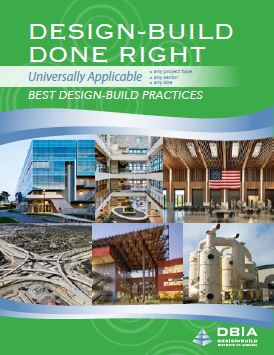
This example illustrates one way in which Owners are working to ensure they pick a team most likely to collaborate successfully. Other possible strategies include increasing the number of face-to-face pre-selection meetings and changing RFP requirements to include materials that better target the soft skills necessary for collaborative teams. While “it’s all about the people” is a common refrain in our industry, volumes of paper with data unrelated to vital people-skills fill traditional RFP requirements focusing that performance analysis away from what can make or break a team’s collaborative success.
Building Trust
The results of both our region survey and the presentation polling, confirm how important building trust is to our respondents. However, recognizing the value of trust and building it are two different matters. As a team leader, if you knew that honesty and listening were the number one and number two things your team was looking for you to deliver — what would be the first thing you would do? How would you develop those traits yourself? How would you start, for instance, the project kick-off meeting?
“Trust and truthfulness go hand in hand,” writes Dr. Jackson in Design-Build Essentials, “In fact, the fastest way to destroy trust on a design-build team or in any relationship is to lie.” Successful team leaders set a clear expectation of honesty from day one. There’s the honesty related to humility — being honest about failure, and willingness to learn from it and improve. And then there’s the honesty of telling it like it is — not candy-coating or spinning the message based on outside factors or agendas. Any type of censoring can be perceived as dishonesty and then trust doesn’t have a chance. This is important to establishing an open and safe environment — one where team members are comfortable being honest and willing to bring down their guard. It is disarming when you witness someone else being vulnerable. Speaking honestly, especially when there are risks, can be very powerful and help build trust. During our presentation, the team wore “I’m ready to listen” t-shirts to visually demonstrate our willingness to establish a safe and open environment.

Overall Results
The costs of poor collaboration are too serious to ignore. Data published in Construction Management and Research show that for projects with below-average levels of team cohesion, 58% delivered over budget and 70% delivered late. On the flip-side, if there was good team collaboration, the majority of projects (53%) delivered on time and on budget (60%).
The results of our survey and in-person polling show, experienced teams know first-hand how critical collaboration is to their project success. While respondents report team member engagement and communication are occurring, there is still work to be done to improve how teams are chosen and managed. Finding that a quarter of collaborative projects are being derailed by individual team members’ personalities highlights the need for improved team building. In order to be effective, we must do more than just gathering teams together in shared workspaces. Beyond technical experience, team members’ personal traits and behaviors should be considered to help build a strong culture of integration. Establishing a collaborative team is more than just creating efficiency and eliminating waste. It’s about establishing a safety zone culture that can shape behaviors and improve collaborative team success. This small study shows we can do better.
